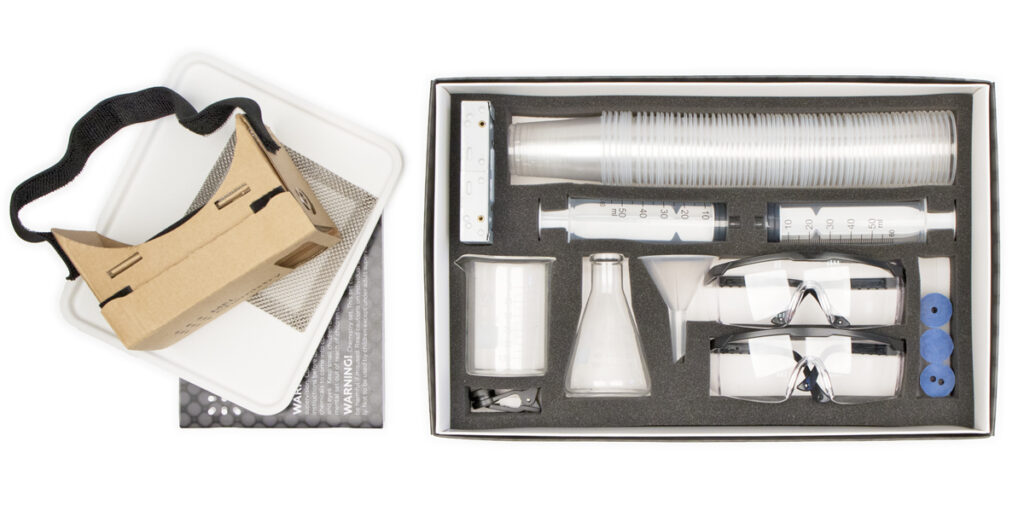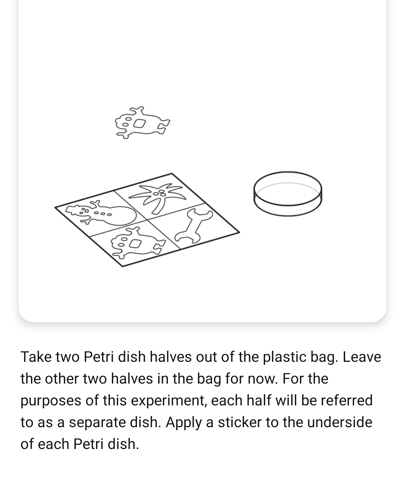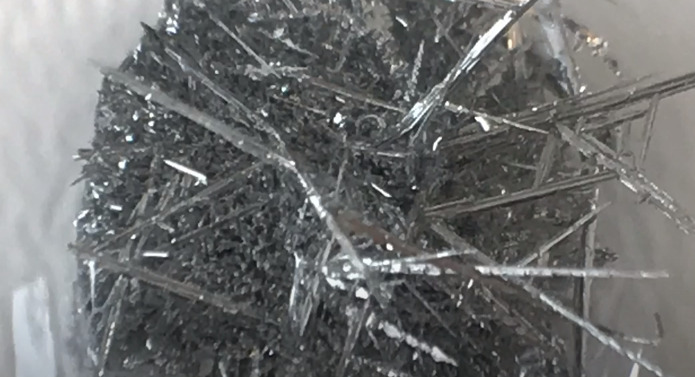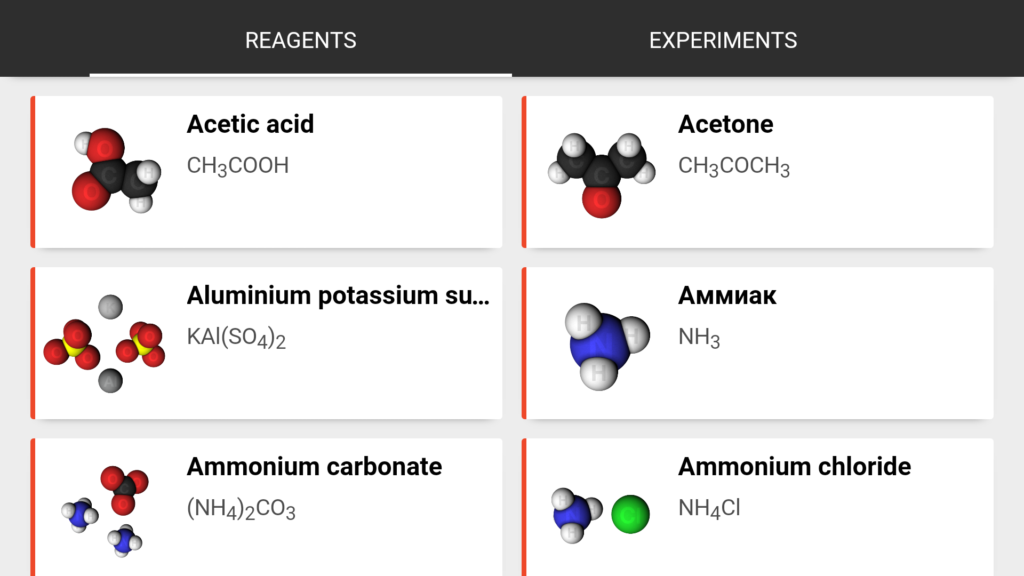
While there are many chemistry kits out there, very few can balance excitement, education, interactivity and safety in the way that Mel Chemistry does.
Although not the cheapest option out there, with its interesting and exciting experiments, rich instructional material, helpful digital apps and innovative VR learning environment, Mel Chemistry sets can go a long way to teach chemistry in a way that’s both effective and captivating.
What We Like
But watch out for…
What is Mel Chemistry & Mel Science?
Founded in 2014, Mel Science is a STEM subscription box service for kids ages 8+ in physics and chemistry.
Mel Chemistry is the company’s subscription box for chemistry and provides kids with exciting, hands-on lab experiments that they can conduct at home, as well as a variety of in-depth learning material to help better integrate it into their learning.
The company has also recently expanded into the world of virtual reality, providing over 70 interactive VR lessons in physics and chemistry.
Age range
The Mel Chemistry set is officially recommended for kids ages 10-16.
Overall, we tend to agree with this age range.
The chemistry experiments themselves are typically what you might find in a high school chemistry course and provide the necessary scientific information and learning to make it a useful hands-on experience for those studying grades 9-12 chemistry.
That said, with proper adult supervision these experiments can be done by younger kids at home and the in-depth explanations are fairly clear and, with help from parents, can help them get their heads around some pretty advanced concepts.
The experiments are fairly interesting, with things igniting, dissolving, growing and changing shape and color, and they do a great job at keeping even younger kids interested and paying attention.
All of this, we feel, makes Mel Chemistry an excellent STEM enrichment tool for younger kids and a great hands-on lab resource for older kids learning chemistry at home.
How does Mel Chemistry work
Mel Chemistry is a subscription chemistry kit.
There are basically two components to the subscription.
In addition to an experiment box, in their first month subscribers also receive a Starter pack, which contains the necessary lab and safety gear and ultimately forms the core of the student’s Mel Chemistry lab.
Every month thereafter subscribers then receive a new box that contains 2-3 experiments that they can conduct, covering different areas and topics in chemistry.
Each box contains all the material necessary to run those experiments (using the lab equipment included in the starter pack), including any extra safety gear, various chemicals and compounds and so on.
Included in the subscription is access to the Mel Chemistry app, which subscribers can download on Android or iOS mobile devices.
It provides various educational material and helps guide students and parents through setting up and conducting the experiments at home.
As part of their Mel Chemistry subscription, subscribers also get access to Mel Science’s Chemistry Virtual Reality lessons for free (these typically cost $9.95 or so each).
These lessons are interactive 3D explorations of various topics in chemistry that supplement the hands-on lab learning with more structured, interactive lessons and virtual activities based largely around molecular chemistry (atoms, electronics, various bonds, the elements and their isotopes, gasses and such).
These are available as a separate app and can be used with the VR goggles included in the Mel Starter Pack or pretty much any other mobile-friendly VR headset.
What’s included in a Mel Chemistry Set
The Starter Kit
Recognizing that not every household has beakers and test tubes lying around, the first Mel Chemistry shipment comes with a starter kit that contains the essential lab gear needed to support the coming experiments.

Lab Equipment
The lab equipment that Mel Chemistry sends helpfully comes in their own separate, protective box.
The company overall does a good job of sending out everything you’ll need to conduct chemistry experiments, with enough duplicates so that parents and students can work together at the same time safely.
Our starter kit included:
- A 100ml (3.3 oz) Erlenmeyer flask for mixing chemicals
- A 150ml (5 oz) beaker
- 250 ml pouring (8.45 oz) beaker
- A variety of disposable plastic cups for holding liquids
- Rubber stoppers
- funnels
- Tray
- Two plastic wraparound lab goggles to protect your eyes (helpful for parent/student learning)
- A nice plastic phone holder
- 16 ml Plastic syringe
- Metal burner
- Cork trivets (to prevent heat damage to your table when you set a hot flask down)
Mel Chemistry’s beakers and flasks are made of Borosilicate (aka Pyrex) glass.
Pyrex is pretty much standard in most labs and stands up to heat and cracking far better than cheaper, soda lime glass.
Although they’re fairly small and compact, at 100 and 150 ml respectively, they’re more than fine for the individual experiments that Mel will send. After all these aren’t designed to stock a real lab.
We think it’s nice that Mel Science sends high quality equipment in their kits instead of a cheaper version.
They lend a greater sense of professionalism and can give kids and teens the feeling that they are doing actual science and not just playing with a toy or being condescended to, and they can be easily reused with other chemistry lesson plans and experiment ideas that parents might find or come up with later on.
Macro Lens for Smartphones
Instead of shipping out a full powered microscope as part of its chemistry starter kit, Mel Science sends kids a macro lens attachment for smartphones instead.
This is an attachment that clips to your phone or tablet, with a magnifying lens that sits over the device’s camera.

Instead of peering into a microscope and needing to adjust it, kids can simply point the phone and look at their screen and even take screenshots for themselves.
From an educational standpoint, we actually have mixed opinions about this.
On the one hand it makes exploring the world of science a lot easier, convenient and more portable than using a microscope, which often needs adjustment and can be a bit tricky with kids especially if they have glasses.
With a macro lens, images are displayed on screen, letting kids zoom in or out with the usual pinching motion.
Further, by attaching to a mobile device, kids and parents can use it at the same time and also take videos or pictures to either keep for themselves or to use in future lesson plans.
Using a macro lens also reduces the cost of Mel Chemistry quite a bit and prevents them from having to send out a cheap, badly made microscope as so many other kits do.
On the other hand, learning to use an actual microscope is a skill that kids should learn, especially if they have an interest in science.
Macro lenses also don’t have as much power in terms of magnification as a standard microscope, which limits how closely kids can look at certain materials and their structures/features.
Overall, however, this is an innovative and interesting solution that works pretty well and can make parent-student interaction with the material a lot easier, since they can both look at and discuss an object’s properties together through a tablet or phone.
And if parents really do want to introduce microscopy into their lesson plans, they can be easily purchased on Amazon and added to the learning plan.
VR Headset
The Mel Chemistry starter pack also includes a Virtual Reality headset.
This is something that stood to us, as most chemistry sets you can buy don’t generally include much in the way of electronic gear.
The VR headset included is made of covered cardboard and its design is, in fact, very much like Google Cardboard. The way it works is you insert your smart phone into the device and it converts it into a VR set.
As part of the physical subscription, parents and students also have access to the company’s suite of VR chemistry lessons, something we’ll discuss later in this review, and this VR set lets you use them if you don’t have virtual reality goggles of your own, which is cool.
The Experiment Sets
Every month for as long as they are subscribed to the program, kids and parents receive a box themed around a particular concept or theme that contains 2-3 experiments that kids can conduct with parental supervision.
With the understanding that the starter pack provides the basic hardware of a chemistry lab, such as beakers and burners, the experiment sets contain the exact chemicals and materials that their particular experiments require.
For example, depending on the experiments in question, a box might include:
- Metals, salts and other materials
- Various agents and reagents
- Bottles
- Tubes
- Wires and clamps
- Petri dishes
- Magnets
- Spare gloves
- And more
Mel Personal experiment assistant
Designed to work alongside the experiment sets, the Mel Personal Experiment Assistant is part of the downloadable Mel Science app.
The assistant helps take parents and students through each experiment in a step by step manner, telling them what they need from the starter kit and from the monthly set and if they need to do something in particular ahead of time, which is very helpful.
The last thing you want, after all, is to prepare a lesson plan for the day and then have to delay it by a couple hours for prep time.
The personal experiment assistant also gives parents instructions on how to set up and conduct the experiment in question, which is helpful if your chemistry lab skills are a little rusty, and actually gives little animated gif-type diagrams that show you how to do things and in what order, rather than just relying on written instructions.

Finally, there is a little section for parents outlining what the final result of the experiment is supposed to be. If the experiment doesn’t work as planned, there is an immediate link to an FAQ, which handily covers some common mistakes people make and more often than not can really help get things back on track.
Finally, the assistant also offers instructions for properly disposing of each experiment, which is important as many of the chemicals can be environmentally toxic and potentially damaging to drains and pipes.
Scientific Descriptions
Beyond the assistant, the Mel Science app also includes a section called Scientific Descriptions.
This section offers a fairly detailed explanation of the science behind each experiment.

The descriptions, while age appropriate, aren’t dumbed down and can get pretty in depth in terms of the chemistry, which is great and makes them a good supplement if you want to integrate them into a chemistry lesson plan.
Using them on their own for learning might be a little tricky, however, as they can touch on concepts and use chemistry terminology with the assumption of previous knowledge on the part of students.
Without a proper review or explanation this can be a little confusing for kids.
Our Experience with Mel Chemistry
The World of Tin
One of the sets our tester received that we decided to include in this review was simply called “Tin.”

This box contained two experiments to be conducted: The Tin Hedgehog and Tin Dendrites.
Inside the box was everything we needed to conduct the experiments safely, including protective gloves, materials and solutions, instructions, wires, petri dishes and even a paper clip.
The box contained nice, glossy cardboard instruction cards that did a pretty good job detailing everything we needed to do step by step in text as well as in a series of IKEA-like graphic instructions and made everything quite clear.
Opening the experiment assistant yielded much of the same information but in more detail, animating the steps and offering more in-depth guidance and troubleshooting.
In this case our student and tester worked mainly with the physical cards using the app as more a supplement and enrichment tool.
Creating a Tin Hedgehog
The first experiment we ran was the Tin Hedgehog experiment. This involved creating a tin salt solution out of Sodium hydrogen sulfate and tin chloride, then adding a small amount of Zinc in the form of a pellet.
The experiment itself was pretty easy and not that demanding in terms of precision.
It was mainly a matter of pouring the contents of one bottle into another, shaking it, filling a container around halfway before inserting a zinc pellet and waiting.
The results, however, were pretty impressive.
Right before our tester’s eyes, tin was pulled out of the solution and settled on top of the pellet of zinc, forming a delicate spiky crystal structure over it that resembled something like a metal hedgehog (hence the name).

Much to our student’s chagrin, once they removed the little hedgehog from the solution, the tin collapsed as it can only retain its shape in the solution.
Explaining the science
The app did a pretty good job explaining the science behind this.
Essentially a classic redox reaction, zinc is a more reactive metal and in tin chloride it begins to donate its electrons, which frees the tin metal which then collects on the zinc pellet in the form of little spikes.
Tin Dendrites
Once again, our testers had to create a tin chloride solution, which they used to fill a petri dish. They then had to hook the petri dish up to a battery pack with a couple of wires and leads that they clipped to either side of the dish.
As a result, little snaking tendrils of tin began to form inside the petri dish and slowly made their way to the opposing electrode, looking something like the branches of a metal tree, which was pretty cool to see.

In conducting the dendrite experiment, our testers had to be a little more precise than the hedgehog experiment. In particular, they were instructed to make sure that the batteries were properly inserted, the clamps properly connected to the wire, that they were touching the solution and so on.
Here the app’s instant FAQ troubleshooting was quite helpful as the experiment won’t work if the set up’s polarity isn’t correct.
Explaining the science
Once again, the scientific explanation was pretty clear and in-depth.
An experiment in electrolysis, when the circuit is complete electrons begin to flow from the negative electrode to the positive. As a result tin ions in the solution accept the electrons from the current and form tin metal, which snakes along towards the other clip.
Other examples of Mel Chemistry sets
Our testers received other kits from Mel Chemistry, some of which we list below to give parents a better idea of what to expect.
| Kit | Experiments |
| Zinc Carbon Battery | Liquid Wires – kids make a paste of graphite and liquid glass and paint a path to light up a light bulb Zinc Carbon Battery – kids use manganese dioxide, graphite and cotton soaked with ammonium chloride to create a battery to power a clock |
| Chemistry for Spies | Magic Paper – kids use potassium iodide and copper sulfate to create an “ink” that becomes invisible with sodium thiosulfate Iron Gall Ink – kids use tannins to write a message and iron sulfate to make it appear Invisible copper – Using ammonia vapor kids reveal a message written in copper sulfate |
| But will it burn? | Igniting iron – kids learn that even iron, if thin enough and under the right conditions, can ignite and burn…sometimes spectacularly Fire Foam – kids make a bubbly concoction of soap and Hydrogen gas. Then set it on fire. |
| Alchemy | Distillation – building their own distillation apparatus to create their own pure ethanol vapor…and then ignite it! Transmutation – using a zinc sulfate solution, zinc wire and heat kids turn a copper coin to “silver” and back again |
In general we found that the experiments Mel Chemistry provides aren’t the craziest, most cutting edge chemistry experiments out there.
Instead, these are variations on various chemistry classics you might find at a high school or even early college level chem class.
They are safe enough to do at home but clear and detailed enough so that elementary and middle school kids can get a lot of learning out of it, which is nice.
But despite being classic, Mel Science has clearly chosen experiments that yield attention-grabbing and sometimes quite spectacular results.
The overall idea is to intrigue kids and get them interested in chemistry with new kits delivered each month that contain things that ignite, produce interesting colors, grow, glow or even replicate something in real life that kids think is cool, spycraft or detective work.
Mel Chemistry: Educational Value
Makes Learning Exciting and Interactive
Unlike some other chemistry sets, which can be a little dry and formulaic, Mel Chemistry presents experiments and concepts in ways kids will find exciting.
They do this by either giving each hands-on chemistry set a theme designed to spark their curiosity and imagination (basing them around Alechemy or Spycraft, for example) or by selecting experiments designed to create a sense of excitement through flames, rapid color changes and more.
With the addition of the VR lessons and apps, Mel Chemistry’s content becomes even more engaging, with cool 3D visualizations and various interactive puzzles and activities that can take learning even further.
In Depth Learning
Aimed at ages 10-16, the experiments Mel Chemistry offers are classics and, combined with the descriptions and explanations provided in the apps, the learning that kids get out of it can actually get pretty advanced and can serve as good enrichment, especially at the younger part of the age range.
Despite being clear, the explanations offered are in-depth and aren’t dumbed down.
They use the proper terminology and chemical formula to explain concepts fully, which is something we appreciate when it comes to STEM learning for kids, and have a variety of diagrams and images alongside the text.
Mel Chemistry also offers follow up questions (under Follow Up) and a variety of related facts (under “That’s Interesting”) that really dive into associated concepts and can be a good jumping off point for further exploration and experiments.

In terms of scope, some chemistry topics we found that were touched upon include:
| Electron movement | Ion exchange reactions |
| Electrolysis | Preparing solutions and reagents |
| Crystalline structures | Elements, their properties and atomic structures |
| Molecular structures and arrangements | Oxidization |
| Acids, bases and concentrations | Solubility |
Mel Chemistry VR App
Mel Chemistry VR Lessons
With a subscription to Mel Chemistry, students and parents can access a suite of Virtual Reality chemistry lessons for free.
These lessons are available in a separate downloadable Mel Chemistry app and work with the included VR headset, or pretty much any other VR headset that you might have, like Oculus or Google Cardboard.
Inside the VR app is a virtual chemistry lab where kids can explore a variety of K-12 topics in molecular chemistry, such as atoms in solids & gases, electron orbitals, isotopes, the periodic table, molecules, gas laws and more.
With a click kids are immersed in short, 3-7 minute videos that consist of 3D models. These are designed to bring the sometimes abstract ideas of chemistry to life by letting students interact with molecules on their screen, turn them, rotate them, build them and even “fly” through them.
There are over 30 lessons in chemistry that align with Next Generation Science Standards (NGSS) in chemistry, and the lessons actually dive into pretty good detail and depth when it comes to learning.
They are interspersed with little interactive questions to keep kids engaged and paying attention and they also include interactive, chemistry related activities that students can do, such as construct atoms, molecules and elements using on screen tools.
Overall, the VR component is a lot of fun and we found it can really enrich the learning that kids get from the experiments Mel Chemistry app.
Kids can first make use of chemicals to see their reactions and interactions with the chemistry sets and then go on to explore their chemical structure in the VR lessons.

Seeing and manipulating representations of abstract concepts can help make them a lot more concrete, and we feel it can be really beneficial for younger kids as it lets parents introduce more advanced things like molecular chemistry into their lesson plans with a lot less confusion.
The interactive elements of the VR experience are also quite good and well made, and the practical activities give kids a little more freedom to play around and learn things on their own.
In fact, because Mel Chemistry’s VR lab often feels a lot like a video game in the way it lets kids get more hands-on experience building and analyzing elements and molecules, we believe it can be a lot more entertaining and engaging than the usual ball-and-stick models chemistry sets come with
Is there anything dangerous about Mel Chemistry?
While the company does an excellent job at providing safety gear, ample warnings and instructions (including disposal instructions), at the end of the day Mel Chemistry is a real chemistry set.
Even if the experiments are selected to be safe enough for home use, they can and do include real chemicals, acids, combustibles and glass objects.
Even though it is designed for older kids and teens, we feel adult supervision is definitely required and Mel Chemistry, like other chemistry sets out there, is not something you can really leave for individual learning.
If you are more interested in letting your kids explore the world of chemistry on their own, or if you prefer not to use this kind of stuff in your house, we would recommend you consider an online chemistry lab, like Labster.com, or one of the many chemistry simulation apps out there.
Who is this set best for?
Parents of younger students interested in a broader STEM education
Mel Chemistry can be an excellent solution for parents interested in giving their elementary and middle school aged kids a bit of exposure to chemistry.
Mel Chemistry kits present chemistry material in a very interesting and hands on way with sometimes very exciting results that can capitate kids imaginations.
After all, what kid doesn’t like things that burn, glow, change colors or even become invisible?
And yet, with its included educational materials and discussions, Mel Science ensures that kids receive the science background to make it all educational as well as fun.
Homeschoolers looking for hands-on chemistry experiments and guidance
Mel Chemistry sets include pretty much everything a homeschool needs to get started doing lab experiments at home, including relevant materials, experiment instructions and an educational component and discussion.
Further, the depth of learning is quite good, professional and varied and lends itself to be easily integrated as a practical and enriching lab component to pretty much any elementary and middle school science lesson plan.
Finally, the step by step instructions, FAQs and in-depth but clear explanations all can be of great help to parents who are a little rusty on chemistry themselves.
Parents struggling introduce abstract concepts to younger students
Many topics in Chemistry, particularly molecular chemistry, are typically often only superficially discussed with younger kids.
This is usually because asking them to grasp atomic structures, bonds, gas laws and their interactions from diagrams and abstract models can be a tall order.
The combination of lab experimentation and the highly interactive VR component of Mel Chemistry can combine to make a very clear and engaging way of explaining and demonstrating complex topics in chemistry to kids in a way that lets them take their time and explore otherwise abstract concepts in a multisensory and interactive way.
If a parent has a child who has a precocious interest in science this can help them introduce more complex topics potentially a lot earlier than they would otherwise be able to, which makes it a great enrichment tool.
Who is Mel Chemistry not for?
Parents interested in independent learning
Some parents want to encourage their children to explore certain subjects on their own, with minimal supervision or parental involvement.
Mel Chemistry kits are designed for two people and are really for parents and students to set up experiments and learn together, with instructions and topics of discussions written for and directed at parents and students to use together.
Further, these are real chemistry sets. They are not designed for kids to use on their own as they often use chemicals and produce reactions that require adherence to safety precautions.
Enrichment of kids at the older end of the age range
Mel Chemistry is a great chemistry set for most kids ages 10-16.
That said, older students looking for chemistry enrichment, such as a talented and advanced grade 10 or 11 student looking to explore AP chemistry or even early college level chemistry topics, may need to look elsewhere.
While Mel Chemistry is very good at hands-on chem work, exploring models and representations, as well as general chemistry knowledge, very advanced students looking for more relevant challenges may need to find a solution that can dive far deeper into and get experience in:
- Balancing equations
- Argumentation
- And interpreting quantitative lab results
- And so on
Price
Note: Prices correct as of writing and all prices are in USD.
Mel Chemistry subscriptions come in three plans – a month to month plan and two prepaid plans of 9 months and 12 months.
| Month to Month | 9 months | 12 months |
| $34.90/month | $31.10/month | $26.20/month |
Compared to other STEM boxes, such as Groovy Lab in a Box, Mel Science kits tend to be a little more expensive.
That said, the learning tends to be a lot more in depth.
They also offer a lot more physical goods than other STEM boxes and the price also includes access to a digital app and VR lessons, which adds to the available content significantly.
That said, when buying a longer term subscription, there is some savings to be had with Mel Chemistry.
9 month plans offering 1 month free, and 12 month plans offering 3 months free.
Or, more plainly speaking, roughly between 11% and 25% off, which is nice.
And, while it is a subscription plan and will auto renew at the end of your subscription, unlike most other subscription boxes Mel Science won’t simply rebill you for the whole period if you forget to cancel.
Instead it shifts back to a month to month basis, which is somewhat more considerate from a customer service point of view.
Is it worth the price
At the end of the day, Mel Chemistry is not the cheapest STEM kit out there by any means.
But if you’re looking for a hands on and engaging way to teach your elementary or middle school student some pretty in depth chemistry, it can be very much worth the price.
For one thing, Mel Chemistry delivers a lot of content for your money.
On top of receiving real life lab gear and a VR set, each month students receive a box with 2-3 really cool and engaging experiments to conduct, as well as ideas for further learning, access to a digital app and the possibility of VR classes that can take learning into a much more high tech and interactive space.
Additionally everything about Mel Chemistry sets, from the Pyrex materials to the actual experiment materials to the look and feel of the instructional apps and software, are very high quality and well designed and made.
This gives Mel Chemistry a much more professional, educational feel compared to other kits out there, which can often feel more like entertainment or even a toy set.
Finally, compared to other STEM chemistry subscription boxes out there Mel Chemistry does provide a lot more in-depth learning for its students.
It covers a wider scope of chemistry subjects and goes a lot deeper in its science explanations, offering various points of discussion and ideas for further exploration of concepts.
When combined with the innovative and interactive VR classroom lessons, Mel Chemistry tends to offer a far deeper and more comprehensive chemistry education than you might expect for a kit aimed at kids and teens.
Bottom Line
Whether it is due to the abstractness of concepts, or the uncertainty many parents have of their own skills in the subject, chemistry isn’t always the easiest subject to explore at home.
While there are many chemistry kits out there very few can balance excitement, education, interactivity and safety in the way that Mel Chemistry does.
Although not the cheapest option out there, with its interesting and exciting experiments, rich instructional material, helpful digital apps and innovative VR learning environment, Mel Chemistry sets can go a long way in teaching chemistry in an effective and captivating way.
Plus, it’s delivered right to your doorstep.
FAQ

About the Author
David Belenky is a freelance writer, former science and math tutor and a tech enthusiast. When he’s not writing about educational tech, he likes to chill out with his family and dog at home.
